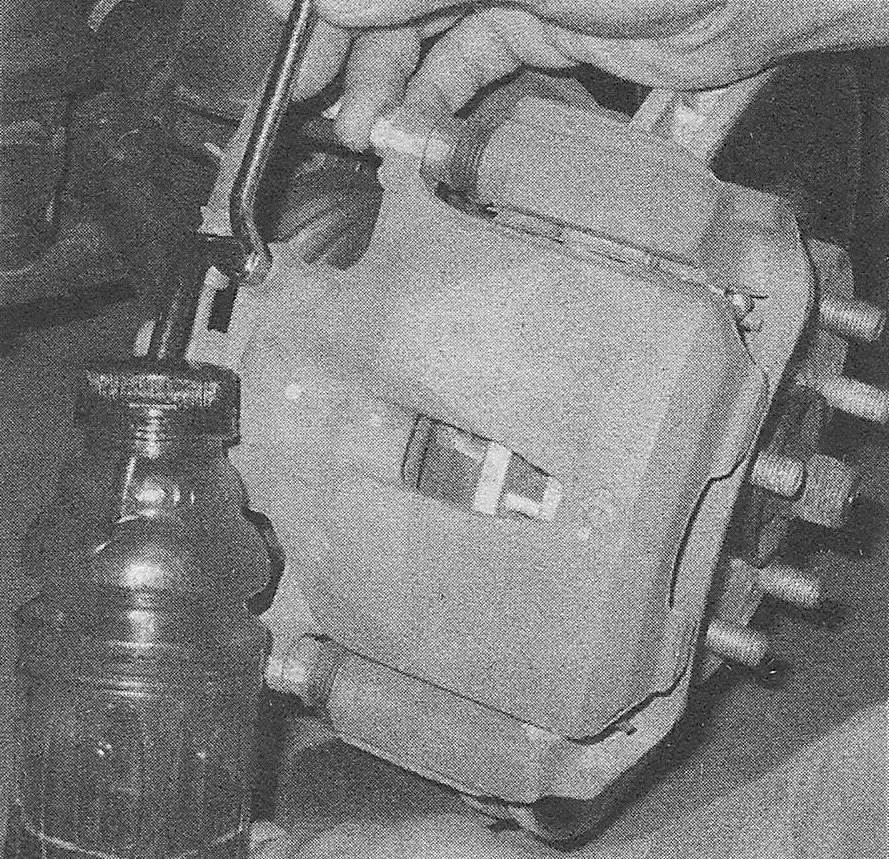Brake hydraulic system — bleeding
Warning: Wear eye protection when bleeding the brake system. If the fluid comes in contact with your eyes, immediately rinse them with water and seek medical attention.
Caution: If after bleeding the hydraulic system, the correct pedal height or feel can’t be made, the brake actuator must be bleed. A factory scan tool or equivalent will be needed, which will necessitate taking the vehicle to a dealer service department or other properly equipped repair facility after service work has been performed.
Note: Bleeding the hydraulic system is necessary to remove any air that manages to find its way into the system when it’s been opened during removal and installation of a hose, line, caliper or master cylinder.
1. You’ll probably have to bleed the system at all four brakes if air has entered it due to low fluid level, or if the brake lines have been disconnected at the master cylinder.
2. If a brake line was disconnected only at a wheel, then only that caliper or wheel cylinder must be bled.
3. If a brake line is disconnected at a fitting located between the master cylinder and any of the brakes, that part of the system served by the disconnected line must be bled.
4. Remove any residual vacuum from the brake power booster by applying the brake several times with the engine off.
5. Remove the master cylinder reservoir cover and fill the reservoir with brake fluid. Reinstall the cover.
Note: Check the fluid level often during the bleeding operation and add, fluid as necessary to prevent the fluid level from falling low enough to allow air bubbles into the master cylinder.
6. Have an assistant on hand, as well as a supply of new brake fluid, a clear container partially filled with clean brake fluid, a length of tubing to fit over the bleeder valve and a wrench to open and close the bleeder valve.
7. Beginning at the right rear wheel, loosen the bleeder valve slightly, then tighten it to a point where it’s snug but can still be loosened quickly and easily.
8. Place one end of the tubing over the bleeder valve and submerge the other end in brake fluid in the container (see illustration).
10.8 When bleeding the brakes, a hose is connected to the bleeder valve at the caliper, then submerged in brake fluid. Air will be seen as bubbles in the tube and container. All air must be expelled before moving to the next wheel

9. Have the assistant depress the brake pedal slowly, then hold the pedal down firmly.
10. While the pedal is held down, open the bleeder valve just enough to allow a flow of fluid to leave the valve. Watch for air bubbles to exit the submerged end of the tube. When the fluid flow slows after a couple of seconds, close the valve and have your assistant release the pedal.
11. Repeat Steps 9 and 10 until no more air is seen leaving the tube, then tighten the bleeder valve and proceed to the left rear wheel, the right front wheel and the left front wheel, in that order, and perform the same procedure. Be sure to check the fluid in the master cylinder reservoir frequently.
12. Never use old brake fluid. It contains moisture that will deteriorate the brake system components.
13. Refill the master cylinder with fluid at the end of the operation.
14. Check the operation of the brakes. The pedal should feel solid when depressed, with no sponginess. If necessary, repeat the entire process.
Warning: Do not operate the vehicle if you’re in doubt about the effectiveness of the brake system.